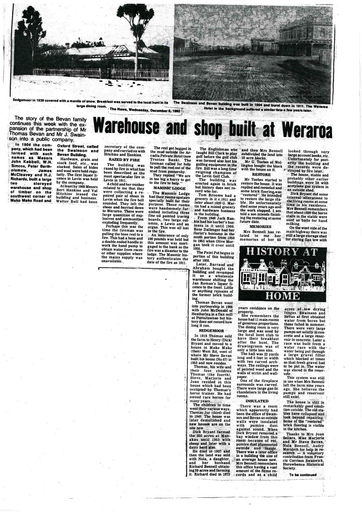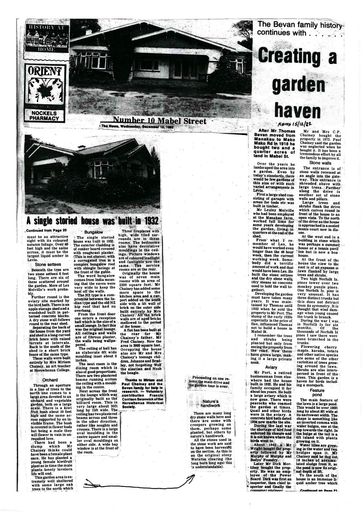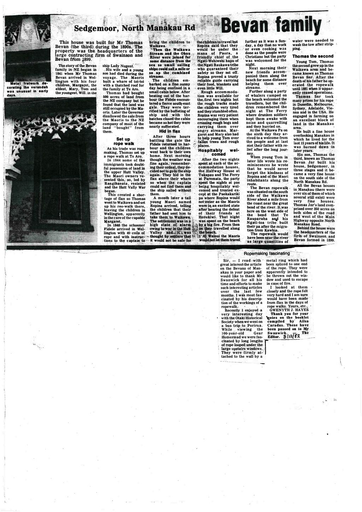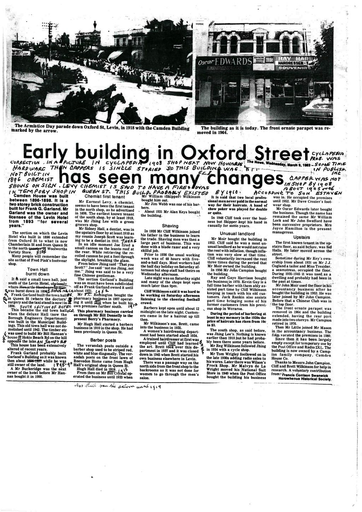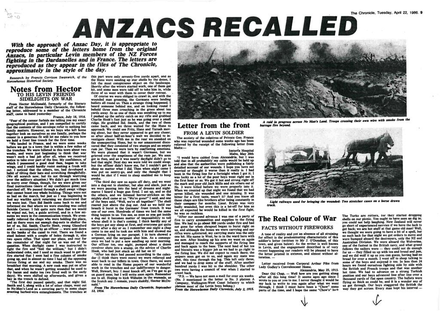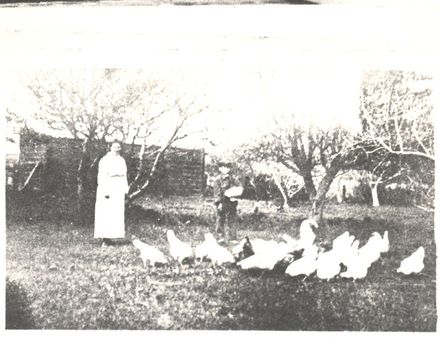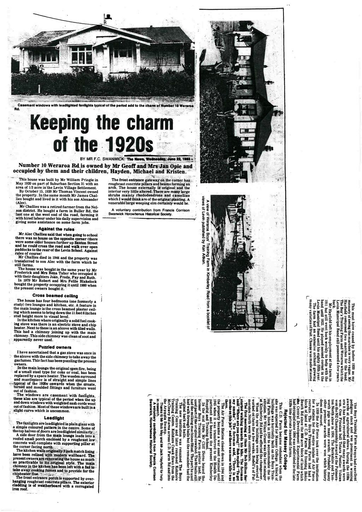The Changing Face of Levin Over A Hundred Years
- Description
On the 1895 photo (featured in part one) a building is shown where the Post Office is now.
... need to insert that photo here ...
The other three corners of Oxford St - Queen St had been built on. Hamilton and Co. advertised in 1898 as a store and draper on No.1 corner! When the 1903 Post Office was planned the corner section known as Hamilton’s Corner was bought, so the shop must have vanished by then.
The photo also showed an odd small building further south. Up to 1900 or later there were no buildings in Queen St east, except a shop being part of the n.e. corner of the original Levin Butchery building where Immortal Phipps had his Silver Grid Restaurant in a second location.
Phipps claimed to be immortal. He left Levin later so it is not known whether he defeated nature or not. His two premises in Levin are shown in old photos.
In Queen St west the only shop buildings were on the north side down to where Typewriter Services are now. There was the corner store of Mary Ann Bowen with the Post Office entrance from Queen St, with Emma Bowen as post mistress and Lou Bowen’s jewellery, etc, business (the start of a chain of such businesses) through to a lock-up shop until 1963, in the south corner of the late K. Shaw Ltd, building, now occupied by Leader and Watt.
 The last building down Queen St was first Post Office and store where Hugh Hall opened his barber’s saloon and sports equipment business in 1898, being the first link in the chain of barbers for the next 90 years.
The last building down Queen St was first Post Office and store where Hugh Hall opened his barber’s saloon and sports equipment business in 1898, being the first link in the chain of barbers for the next 90 years. On the south side there was only the side frontage of the Levin Hotel, its stables and the town hall built by Mr Frank Garland, at the time owner of the hotel property, in 1898 after the fire destroyed the first public hall.
In Bath St east or west there were no commercial buildings up to 1906 when the Salvation Army hall was built. There were no commercial buildings south of about six sections north of Bath St. in Oxford St, up to around 1904.
Houses were built well before 1900 and onwards, clustered up close to Oxford St in Bath St west up to the present Cobb and Co. tavern on both sides. In Bath St east houses were built in the same area from the ladies bowling green to Winchester St. Queen St west had several houses early from the late Contact House to the Salisbury St corner on the north side, until ousted in recent years by business premises.
The corner section once had a Salvation Army hall about 1900 on it but gone before about 1918 with no building later.
The Maori Land Court had hearings in this hall. Further west there were no houses as apparently the block between Salisbury St and Weraroa had been bought by stock firms early, for future saleyards. On the south side the side frontage of the Levin Hotel, to Chamberlain St, the school reserve to Salisbury St and the Levin Park Domain prevented any housing on the south side to Weraroa Rd. Houses were built early in Oxford St nth on both sides from where the Levin Club is now, counting it. And in Kent St early housing existed as far as Winchester St.
Salisbury St north of Queen St from one section off the corner and the east side and from the future saleyard site on the west side, and the side streets connecting to Oxford St and Bristol St were also early housing areas.
In all areas empty sections persisted for many years. Outside these housing areas were the small rural sections of from 5 to 20 acres (2Ha to 8Ha) which would have only the owner’s house on them.
After 1900 some of these rural sections were subdivided in house sections especially those nearest town. Some took up to the 1950s to be subdivided. Housing on central areas was often on large sections subdivided many years later.
Livery Stables
These were for ’parking’ horses and horse vehicles. They were essential for good living (for the affluent, others walked or biked), while the people went about their business in town.
If wanted, horses would be fed and watered, even groomed, in stalls. Bradley Bros. (where Levin Music and Toyland are now) seem to have been the first stables about 1897 though Jack Smiths’ stables about where the ANZ Bank is now could have been as early.
Jack Smith shifted his stables after 1903 to where the Memorial Hall is now. Bob Bradley said in a published story that up to 200 horses would be accommodated in busy times.
The stables would not have accommodated all these, so many were probably kept in the back section and the period would probably have been nearer the 1920s, when Levin district’s population had grown.
I can remember before 1918 looking in the wide door of Bradleys, seeing a hostler (an employee who cared for the horses) Albert Wells, who had a wooden artificial peg leg and being puzzled by it.
About 1920 he ran his own stable in Queen St where Mitre 10 is now. There were hitching rails, one with a step for riders, not very agile, to mount their horses from, around the town. There were also the timber protections of the young plane trees and later the trees after the protections had been removed, to tie the horses to.
Horses harnessed to vehicles generally would stand without being hitched to anything. There was a horse water trough by the Post Office in Queen St from 1915. Horses were still the main means of providing transport into the 1920s and to a certain extent into the early 1930s, although motor vehicles were becoming popular then.
The Oxford St Plane Trees
Queen Victoria attained the record reign of any British sovereign in 1897. It was also her diamond (60 years) anniversary but the emphasis in celebrations was on the record reign.
Celebrations were held commemorating it worldwide in the far-flung British Empire. In Levin a Record Reign Committee was formed, with Dave Smart as chairman, to promote the planting of plane trees in Oxford St, to mark the occasion for all time. This was done from Bath St northwards to Devon St, in 1897 and at Weraroa, from near Mako Mako Rd east (now Liverpool St) to the station.
Timber protections were built around the trees being there for many years until the trees were large enough to be safe from horses and horse traffic.
Some trees had either died after planting or soon after as before 1920 there were gaps in the rows. Over the years there have been several attempts in council to remove the trees, on one pretext or another all ending in failure.
One attempt in 1958 ended in the council deciding to replant the gaps in central Oxford St, 12 in all.
In about the 1950s the trees were decorated with coloured lights for the Christmas period. Long wooden tripods were mounted in and above the trees with 1500 electric lights. From the station to Exeter St the sight was beautiful at night.
In the 1970s deterioration of wiring and high cost of renewal caused a much more feeble decoration. The Weraroa trees were removed about the 1970s on the feeble excuse that kerb and channelling could not be done with the trees there; on a footpath that was far too wide for the station pedestrian traffic at the time.
In the 1970s the footpath from Durham St south was narrowed to almost single file so Oxford St could be widened. This footpath has to take heavier traffic than the above one.
In 1988 five trees were removed because of disease, and replacements planted.
THE NEWS, WEDNESDAY, AUGUST 9, 1989.
Identification
- Date
- August 9, 1989
Taxonomy
- Community Tags




